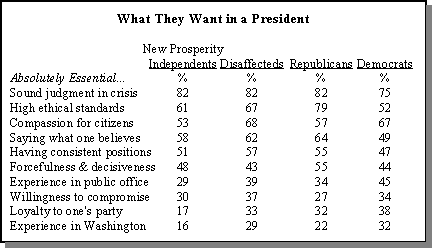With all eyes now firmly focused on a general election match-up between Al Gore and George W. Bush, the big question is which way independents will go — particularly those independents who have been supporting John McCain. While McCain’s popularity has focused more attention on this crucial bloc, independents are the swing voters in every presidential election. As they woo these unpredictable voters, Gore and Bush will quickly discover that all independents are not created equal.
 Occupying prime turf in the middle of the electorate are two disparate groups of independents identified by the Pew Research Center in its political typology for the 2000 election. New Prosperity Independents are well-educated moderates who are reaping the benefits of the new economy. They are tolerant on abortion, gay rights and immigration, but express few concerns about the conditions of blacks. Disaffecteds are in some ways the reverse image of the New Prosperity Independents. Largely bypassed by the economic boom, they are less optimistic, more financially stressed and far more conservative than New Prosperity Independents on many social issues. Together, these groups comprise 21% of registered voters, although Disaffecteds say they vote less frequently than the New Prosperity Independents.
Occupying prime turf in the middle of the electorate are two disparate groups of independents identified by the Pew Research Center in its political typology for the 2000 election. New Prosperity Independents are well-educated moderates who are reaping the benefits of the new economy. They are tolerant on abortion, gay rights and immigration, but express few concerns about the conditions of blacks. Disaffecteds are in some ways the reverse image of the New Prosperity Independents. Largely bypassed by the economic boom, they are less optimistic, more financially stressed and far more conservative than New Prosperity Independents on many social issues. Together, these groups comprise 21% of registered voters, although Disaffecteds say they vote less frequently than the New Prosperity Independents.
What links these groups is their estrangement from the two parties, weariness with the problems of the Clinton administration and a critical attitude toward government generally. But their vastly different attitudes and policy positions dispel any notions that independents are monolithic. Even their lifestyles are strikingly divergent: Only 18% of New Prosperity Independents smoke regularly, compared to 41% of Disaffecteds (the greatest percentage of any group identified by the typology).
Equally important, their substantive differences with the two major parties make them elusive political targets for Gore and Bush. With pro-business leanings, New Prosperity Independents side with the GOP on taxes and other economic questions. But on many social issues, they are at least as liberal as Democrats, and in some cases more so. On abortion, for instance, nearly half (47%) of this group strongly identifies with the pro-choice movement, compared with 43% of Democrats and 26% of Republicans. A strong majority (66%) of New Prosperity Independents favor restricting the sale of handguns; fewer Democrats (61%) and far fewer Republicans (51%) agree.
The Disaffecteds look more like Republicans than Democrats on social issues. Less than half (48%) support restrictions on handgun sales. More than half (55%) of the Disaffecteds want to end bilingual education, compared to 56% of Republicans, 44% of Democrats, and 44% of New Prosperity Independents. On abortion, this group falls between Republicans and Democrats, with 35% strongly identifying with the pro-choice movement.
But many of the Disaffecteds are in difficult financial straits — more than one-quarter (28%) describe themselves as poor, compared with 16% of the general public. Not surprisingly, they side with Democrats on the question of raising the minimum wage. More than eight-in-ten (86%) of the Disaffecteds support increasing the minimum wage, against 91% of Democrats and 69% of Republicans. On the environment as well, the Disaffecteds come down closer to the Democrats than Republicans. Nearly half (49%) strongly identify themselves as environmentalists, against 46% of Democrats and 33% of Republicans.
 It is not just issues that divide these groups, and set them apart from the two major parties. They also want different qualities in the next president. Like Democrats, Disaffecteds prize compassion; nearly seven-in-ten (68%) consider compassion for the average citizen absolutely essential, against 67% of Democrats and 57% of Republicans. Just over half of New Prosperity Independents (53%) consider compassion an essential quality.
It is not just issues that divide these groups, and set them apart from the two major parties. They also want different qualities in the next president. Like Democrats, Disaffecteds prize compassion; nearly seven-in-ten (68%) consider compassion for the average citizen absolutely essential, against 67% of Democrats and 57% of Republicans. Just over half of New Prosperity Independents (53%) consider compassion an essential quality.
New Prosperity Independents consider prior Washington experience to be less essential than either Republicans or Democrats. Just 16% of this group highly values this experience, compared to 22% of Republicans and 32% of Democrats. These voters also place little stock on party loyalty — which made them a logical constituency for McCain. Just 17% consider party loyalty absolutely essential, against 32% of Republicans and 38% of Democrats. Experience and loyalty matter much more to Disaffecteds than New Prosperity Independents — 29% highly value Washington experience and one-third says party loyalty is absolutely essential.
McCain was successful in attracting these independents, but his appeal was based mostly on the strength of his biography, not his stance on issues. Gore and Bush face difficult challenges in tailoring a message for these different groups. Gore needs to tug at the economic insecurity of the Disaffecteds and appeal to the tolerance of the New Prosperity Independents. Bush will likely try to exploit the Clinton fatigue in both groups, while working to avoid being seen as intolerant by the New Prosperity Independents and hard-hearted by the Disaffecteds.


